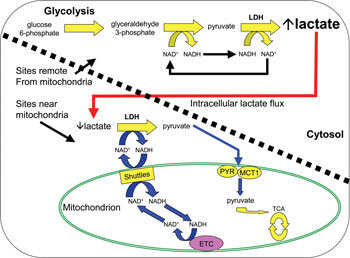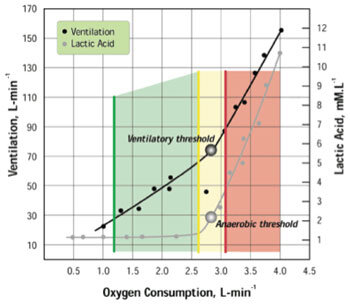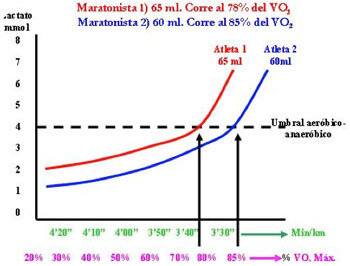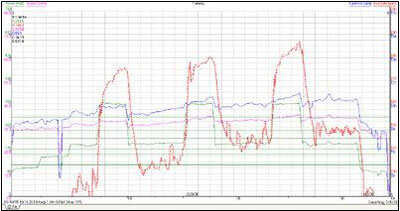The importance of the anaerobic threshold

Our collaborator Ricard Perez This time he tells us the importance of being clear about the concept of the anaerobic threshold.
If you would like to improve your results in a training or competition, you need to understand the importance of anaerobic threshold
As you well know, there are some training areas which are defined according to the intensity level (% of our maximum pulsations).
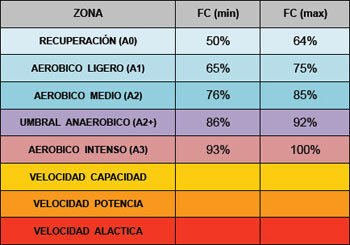
Within these areas, we have the recovery zone, which is below the 63% -65%.
In this area, the intensity of work is so low, that blood can easily circulate through the blood vessels and make a cleaning work of the residual elements that may exist.
This area is the famous active recovery the day after a race, and it helps us to find ourselves better after doing the session than before we started.
The next area is known as the fat-burning training, that is, if we move to an intensity between 65% and 75%, what we are doing is activate our metabolism and use metabolic pathways that allow maintaining this level of intensity for a long time.
You have to be very careful not to confuse that to "burn fat" we must do very long and very smooth sessions, because if we take this concept to the extreme, what will happen to us is that we will be working in the recovery zone (since there is people who say that when more comfortable training, more fat burns), so the famous fat-burning area is light aerobics, and not the recovery zone.
But let's go to what interests us, the anaerobic threshold zone.
This zone is what marks the point at which our body accumulates so much lactate that we can no longer assimilate.
What is lactate?
Seen quickly, lactate is a waste substance that generates our body at the moment of obtaining the necessary energy to allow us to move.
If we exercise in a very intense way, we need a lot of energy, so many internal reactions are generated in our body and consequently a lot of waste substance is produced.
Our body can assimilate lactate values up to 3 mMol / l without problems, and this occurs at rates below the anaerobic threshold.
In summary, if we work below the anaerobic threshold, we generate so little lactate that our body can assimilate (and clean) while we continue exercising.
If we work above the anaerobic threshold, our body generates greater amounts of lactate (I have come to see cases of 17 mMol / l) and this lactate accumulates in our body and there comes a time when we are not comfortable (call him pájara, call him Mazo Man, call him stay empty ...).
And what about the anaerobic threshold?
First of all we have to know what is the anaerobic thresholdand it's just a workspace. That is, if we work between the 85% and the 90%, we are working in the anaerobic threshold zone.
If you search for information on the Internet, you will find many different definitions of training zones, and scientists who defend that the threshold zone is between 82% and 84%, others that indicate that the threshold is above 86%, etc.
In my case, I define the threshold between 86% and 92%, and my reasons I have (secret summary, hahaha), basically because it is directly related to the training system I use.
As we are interested in being able to work efficiently in this area, in order to go as fast as possible (it is assumed that more speed more pulsations) but without spending laps to not accumulate too much lactate.
So, whenever you make a race or training "for sensations", you are already unconsciously looking for this rhythm (the famous "ritmillo" or "go with the hook").
What is the good new ?
Well, with training we can move the threshold, that is, we can accustom our body to work with high intensities and make him get used to working with values of 3-4 mMol / l.
What is the result, because if our body gets used to working in this area, in the end it will be so accustomed that it will want more, and that translates into that we can force a little more rhythm without generating extra lactate.
Obviously, this explanation is very simplified, but what interests me is that you understand the concept perfectly, so if you understand this idea well (even if it is not very technical) you will have understood a very important part of the training.
Do you understand the graph?
The difference between the red athlete and the blue athlete is that the blue athlete has a higher anaerobic threshold, which means that it can go to a greater intensity than the red athlete before accumulating the fateful 4 mMol / l of lactate.
In short, that the blue athlete can go at a higher speed than the red athlete, and for longer.
If the red athlete tried to follow the rhythm of the blue athlete, he would be working above his threshold and could not stand the rhythm for long.
Attention XNUMX-hour. Through good training, we we can turn from red to blue, that is, we can improve our anaerobic threshold and do what is technically known as "move our curve to the right".
For this reason it is so important to detect our threshold, or know our pace of competition, to make our body recognize it and can adapt to work in this area and eventually improve the threshold.
To improve my brands, should I always work in the threshold zone?
This is one of the big mistakes of training: think that to improve everything I have to do is train in the area of the anaerobic threshold.
If it were so easy, the training would have no secret: to be world champion you only need to buy a heart rate monitor and train for example at 82%
We must work on speed, resistance, strength, technique, etc., and that means we have to be able to work in different training zones to improve each of these aspects (I guess it's clear that when we improve our speed by doing a full sprint, we are quite above the 95% ...).
Now you understand why the anaerobic threshold is so important (and because there are people who are mistakenly obsessed with working only in the threshold zone ...)
Further information: http://www.ricardperez.com/
There are no previous results.







